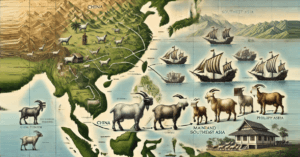How Goats Migrated to Southeast Asia: Genetic Evidence from DNA Studies
The study explores the genetic history of goats in Island Southeast Asia (ISEA), revealing how human migration and trade influenced their distribution. Researchers analyzed mitochondrial DNA (mtDNA) and the SRY gene in goats from the Philippines and Indonesia. Findings show that most goats in the Philippines belong to haplogroup B (73.8%) and haplogroup A (26.2%), while Indonesian goats are entirely haplogroup B. This suggests two migration routes: one from China/Taiwan to the Philippines and another from Mainland Southeast Asia to Indonesia. A rare Y-chromosome haplotype (Y2A) found in ISEA but absent in Mainland Southeast Asia indicates genetic mixing through Indian Ocean trade, likely influenced by European interactions between the 16th and 19th centuries.
The Philippines displayed higher genetic diversity in haplogroup A, whereas Indonesia showed greater diversity within haplogroup B. Historical records and studies on other domestic animals, such as dogs and pigs, support similar migration patterns, reinforcing the role of maritime trade in shaping genetic diversity. Additionally, haplogroup B’s presence in parts of Africa suggests that Austronesian migrations contributed to genetic exchange across the Indian Ocean. The absence of Y2A in Mainland Southeast Asia further supports its introduction through European and African trade routes.
With livestock frequently transported across historical trade networks, this study highlights the role of migration and trade in shaping goat genetics in ISEA, providing valuable insights for understanding human-animal movements and livestock conservation.

How Goats Migrated to Southeast Asia: Genetic Evidence from DNA Studies
The history of goat migration and spread in Island Southeast Asia (ISEA), which includes the Philippines and Indonesia, has been unclear due to limited genetic studies and archaeological evidence. However, recent research analyzing goat DNA from these regions has provided new insights into their origins and movement. By examining two key genetic markers—mitochondrial DNA (mtDNA) for maternal ancestry and the SRY gene for paternal lineage—researchers have uncovered valuable details about how goats migrated alongside humans through trade and settlement.
Maternal Lineage: Tracing Goat Ancestry
The study found that goats in the Philippines primarily belong to two genetic groups: haplogroup B (73.8%) and haplogroup A (26.2%). In contrast, all goats in Indonesia (100%) belong to haplogroup B. This suggests two distinct introduction routes: one from China or Taiwan to the Philippines and another from Mainland Southeast Asia (MSEA) to Indonesia. Haplogroup B is more common in ISEA than in MSEA but exhibits lower genetic diversity, likely due to geographical barriers causing a bottleneck effect. Interestingly, haplogroup B is also found in parts of Africa, including South Africa, Namibia, and Tanzania, but is absent in northern Africa. This suggests its spread may have been facilitated by Indian Ocean trade routes, which were active for centuries.
Paternal Lineage: The Role of Trade and Migration
The study also analyzed the SRY gene, which traces paternal ancestry. Researchers identified five Y-chromosome haplotypes, with one rare haplotype, Y2A, found in goats from the Philippines and Indonesia but absent in MSEA. Since Y2A is typically found in Africa and southern Europe, its presence in ISEA suggests that goats were introduced from these regions, likely during the Age of Discovery (16th–19th centuries) when European traders used Southeast Asia as a hub for the spice trade. Additionally, another haplotype, Y2B, was detected in northern Madagascar, further supporting genetic exchange between Southeast Asia and Africa via maritime trade.
Genetic Diversity and Migration Patterns
The Philippines displayed higher genetic diversity in haplogroup A but lower diversity in haplogroup B compared to other Southeast Asian countries. Conversely, Indonesia, despite exclusively having haplogroup B, exhibited greater genetic diversity within this group. This suggests that goats in the Philippines may have migrated from South Sulawesi (Indonesia) to Mindanao (Philippines) due to their geographical proximity. The study also proposed that haplogroup A goats arrived in the Philippines via China or Taiwan, while haplogroup B goats traveled from the Malay Peninsula to the Philippines through Indonesian islands. Simulation models indicated that multiple migration routes, rather than a single pathway, were likely involved, with some genetic mixing occurring in the Philippines.
The Role of Human Trade and Migration
The spread of goats in ISEA closely aligned with human migration and trade. Historical records indicate that Islamic merchants were active in the region as early as the 9th century, followed by European colonizers in the 16th century. These trade networks facilitated the movement of livestock, including goats, across the Indian Ocean. The Maluku Islands, South Sulawesi, and Mindanao were significant trading centers, which may explain the higher frequency of Y2A in these areas. Additionally, the migration of Austronesian peoples from Indonesia to East Africa and the Arabian Peninsula likely contributed to the spread of haplogroup B to Africa.
Connections to Other Domestic Animals
Studies on other domesticated animals, such as dogs and pigs, support the theory that goats followed similar migration routes. Research suggests that dogs and pigs migrated from Taiwan to the Philippines and from MSEA to Indonesia between 5,000 and 2,000 years ago. Since animal movements were often linked to human migrations, it is likely that goats traveled along the same pathways. Similarly, studies on chickens indicate they were transported across the Indian Ocean, resulting in genetic exchange between Southeast Asia and Africa.
Conclusion
This study provides valuable insights into the complex history of goat migration in ISEA, shaped by human trade, migration, and colonization. The findings suggest two primary introduction routes—one through China/Taiwan and another from MSEA to Indonesia—while also revealing genetic mixing with African and European goats through Indian Ocean trade. Understanding these genetic patterns helps researchers trace the history of human and animal movement across Asia and beyond while contributing to the conservation of livestock genetic diversity.
You must be logged in to post a comment.